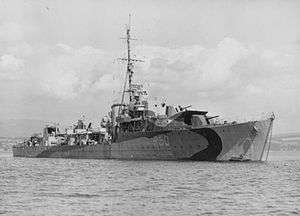HMS Venus (R50)
 Venus in August 1943 | |
| History | |
|---|---|
| Name: | HMS Venus |
| Ordered: | 1 September 1941 |
| Builder: | Fairfield Shipbuilding and Engineering Company, Govan, Scotland |
| Laid down: | 12 January 1942 |
| Launched: | 23 February 1943 |
| Commissioned: | 28 August 1943 |
| Identification: |
|
| Honours and awards: | |
| Fate: | Sold for scrap in 1972 |
| Badge: | On a Field Blue, the symbol of the planet Venus Gold. |
| General characteristics V-class destroyer | |
| Class and type: | V-class destroyer |
| Displacement: |
|
| Length: | 363 ft (111 m) |
| Beam: | 35 ft 8 in (10.87 m) |
| Draught: | 10 ft (3.0 m) |
| Propulsion: |
|
| Speed: | 37 knots (43 mph; 69 km/h) |
| Range: | 4,860 nmi (9,000 km) at 29 kn (54 km/h) |
| Complement: | 180 (225 in flotilla leader) |
| Armament: |
|
| General characteristics Type 15 frigate | |
| Class and type: | Type 15 frigate |
| Displacement: | 2,300 long tons (2,337 t) standard |
| Length: | 358 ft (109 m) o/a |
| Beam: | 37 ft 9 in (11.51 m) |
| Draught: | 14 ft 6 in (4.42 m) |
| Propulsion: |
|
| Speed: | 31 knots (36 mph; 57 km/h) (full load) |
| Complement: | 174 |
| Sensors and processing systems: | |
| Armament: |
|
HMS Venus was a V-class destroyer of the Royal Navy that saw service during the Second World War. She was built by Fairfield Shipbuilding and Engineering Company, of Govan, Scotland and launched on 23 February 1943.
Service history
Second World War service
She participated in the Battle of the Malacca Strait with the destroyers Saumarez, Verulam, Vigilant, and Virago which culminated in the sinking of the Japanese cruiser Haguro on 16 May 1945.
Post war service
Between 1946 and 1949 Venus was part of the 3rd Destroyer Flotilla, based in the Mediterranean. This included work as part of the Royal Navy patrols preventing illegal Jewish immigration into Mandatory Palestine. In June 1946 she intercepted Josiah Wedgewood. In the same year Venus and Virago participated in the rescue of crew from the British Tanker Empire Cross, which caught fire, exploded and sank at Haifa, Palestine,[1] with the loss of up to 25 lives.[2]
Between 1949 and 1951 she was held in reserve at Devonport Dockyard. Between 1951 and 1952 she was converted at Devonport into a Type 15 fast anti-submarine frigate, with the new pennant number F50. Following conversion she became leader of the 6th Frigate Squadron. In 1953 she took part in the Fleet Review to celebrate the Coronation of Queen Elizabeth II.[3] In 1955 she was refitted for work as part of the Dartmouth Training Squadron.[4]
Decommissioning and disposal
In 1964 Venus went to reserve and in October 1969 was in use as a target to measure the effects of ship to ship use of the Sea Dart missile system. She was sold to Thos W Ward for scrapping and arrived at their Briton Ferry yard on 20 December 1972 to be broken up.
Commanding officers
| From | To | Captain |
|---|---|---|
| 1943 | 1944 | Cdr J S M Richardson DSO RN |
| 1944 | 1945 | Cdr H G D de Chair DSO RN[5] |
| 1951 | 1952 | Under conversion to Type 15 Frigate |
| 1952 | 1954 | Captain Colin C Martell RN |
| 1955 | 1956 | |
| 1957 | 1958 | |
1958 - 1960 Captain P N Howes DSC [6]
References
- ↑ Mitchell, W.H.; Sawyer, L.A. (1995). The Empire Ships. London, New York, Hamburg, Hong Kong: Lloyd's of London Press Ltd. p. not cited. ISBN 1-85044-275-4.
- ↑ "Haifa Tanker Explosion". The Times (50521). London. 5 August 1946. col E, p. 3.
- ↑ Souvenir Programme, Coronation Review of the Fleet, Spithead, 15th June 1953, HMSO, Gale and Polden
- ↑ Critchley, Mike (1982). British Warships Since 1945: Part 3: Destroyers. Liskeard, UK: Maritime Books. p. 72. ISBN 0-9506323-9-2.
- ↑ "HMS Venus (R 50)". Uboat.net. Retrieved 2 May 2015.
- ↑ BRNC Blue Book January 1960
Publications
- Colledge, J. J.; Warlow, Ben (2006) [1969]. Ships of the Royal Navy: The Complete Record of all Fighting Ships of the Royal Navy (Rev. ed.). London: Chatham Publishing. ISBN 978-1-86176-281-8. OCLC 67375475.
- Raven, Alan; Roberts, John (1978). War Built Destroyers O to Z Classes. London: Bivouac Books. ISBN 0-85680-010-4.
- Whitley, M. J. (1988). Destroyers of World War 2. Annapolis, Maryland: Naval Institute Press. ISBN 0-87021-326-1.